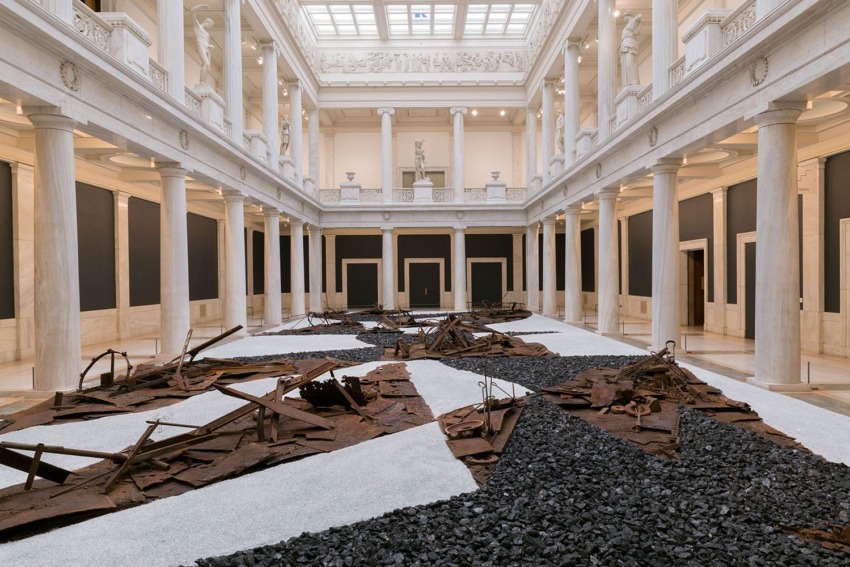See Highlights of the 57th Carnegie International Exhibition
The Carnegie International kicked off in Pittsburgh last weekend, featuring over 30 international artists

The 57th edition of the Carnegie International kicked off in Pittsburgh this past weekend to considerable fanfare, with a gala dinner toasting its opening as well as the announcement of the exhibition’s prizewinners. The show, the country’s oldest survey exhibition (it’s one year younger than the Venice Biennale), brings together works of over 30 international artists (some commissioned and others preexisting pieces) and integrates them into the many galleries of the Carnegie Museum of Art, in some cases intermingling them with regular displays.
Curated by Ingrid Schaffner, the contemporary art in the show—in Schaffner’s words—“bursts across medium, craft, and discipline.” As such, the show features standout paintings by Sarah Crowner and Lynette Yiadom-Boakye, a beguiling video work and installation by Alex Da Corte, and a ballet performance in and around an installation by Karen Kilimnik. It extends from the façade of the building, where an immense site-specific sculpture by El Anatsui (a major new commission) welcomes visitors to the galleries of the museum, to the Hall of Miniatures, where Jeremy Deller incorporates tiny functioning television sets inside the dollhouse-like displays.
Many of the works were created with the history of the institution and with Pittsburgh itself in mind. Inspired by the names of important historical figures that are inscribed in the façade of the museum, Tavares Strachan added his own set of names of significant people to the exterior of the building, in neon. In the artist’s attempt to correct what he calls the “social amnesia of forgetting,” he makes visible the people heretofore forgotten by history. Now, along with Shakespeare and Michelangelo, there are also the names of Robert Lawrence, the first African-American astronaut, and English chemist Rosalind Franklin, who contributed to our understanding of DNA.

Artist Park McArthur had the sounds of a quarry in Larvik, Norway, recorded and then amplified to haunting effect in a gallery and the lobby of the museum. In that the Carnegie Museum of Art is built almost entirely of larvikite, the industrial sounds are said to be, according to the International guide, “essentially of the building itself.”
Using the materials connected to Pittsburgh’s industrial roots was also the aim of art collective Postcommodity (whose members, from varying indigenous nations, are Cristóbal Martínez, Raven Chacon, and Kade L. Twist), which transformed the floor of the Hall of Sculpture into a Navajo sand painting (a ceremony of picture making and chanting that is completed with the image being swept up) composed of glass, steel, and coal, for what was one of the most breathtaking installations at the International. Apart from the visceral impact of seeing so much steel, coal, and glittering crushed glass deposited on the floor of the elegant space, the work’s power lay in part in its ability to invoke the complex history of the founder of the institution in light of contemporary geopolitics, or what Twist called the “cautionary tales of self-determination.”

“We wanted to bring to the materials that Andrew Carnegie got rich off of and reclaim those materials as resources,” said Martinez, “and reposition them in a way that could really begin to dismantle some of the puritanical, state-powered articulation or fantasy of things like Manifest Destiny, entrepreneurship, and labor.”
A tricolor pattern, which was formed on the floor from the materials, also serves as inspiration for a jazz musician who activates the space four times per week by interpreting the work as a musical score. While the purpose of such a sand painting ordinarily “would be to heal a space or to heal a patient,” according to Chacon, for this work, “it was for activating sound, to allow sound to organize itself…to be a shared experience between a performer and an audience.”
The work won the Fine Prize while London-based artist Lynette Yiadom-Boakye won the Carnegie Prize for her sensitive and captivating figurative paintings on linen depicting young black men and women rendered in soft, gestural brushstrokes.






